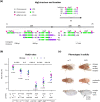Imaginal disk growth factors are Drosophila chitinase-like proteins with roles in morphogenesis and CO2 response
- PMID: 36576887
- PMCID: PMC9910413
- DOI: 10.1093/genetics/iyac185
Imaginal disk growth factors are Drosophila chitinase-like proteins with roles in morphogenesis and CO2 response
Abstract
Chitinase-like proteins (CLPs) are members of the family 18 glycosyl hydrolases, which include chitinases and the enzymatically inactive CLPs. A mutation in the enzyme's catalytic site, conserved in vertebrates and invertebrates, allowed CLPs to evolve independently with functions that do not require chitinase activity. CLPs normally function during inflammatory responses, wound healing, and host defense, but when they persist at excessive levels at sites of chronic inflammation and in tissue-remodeling disorders, they correlate positively with disease progression and poor prognosis. Little is known, however, about their physiological function. Drosophila melanogaster has 6 CLPs, termed Imaginal disk growth factors (Idgfs), encoded by Idgf1, Idgf2, Idgf3, Idgf4, Idgf5, and Idgf6. In this study, we developed tools to facilitate characterization of the physiological roles of the Idgfs by deleting each of the Idgf genes using the CRISPR/Cas9 system and assessing loss-of-function phenotypes. Using null lines, we showed that loss of function for all 6 Idgf proteins significantly lowers viability and fertility. We also showed that Idgfs play roles in epithelial morphogenesis, maintaining proper epithelial architecture and cell shape, regulating E-cadherin and cortical actin, and remarkably, protecting these tissues against CO2 exposure. Defining the normal molecular mechanisms of CLPs is a key to understanding how deviations tip the balance from a physiological to a pathological state.
Keywords: Drosophila; CO2 exposure; cell migration; chitinase-like proteins; fertility; hypercapnia; imaginal disk growth factors; morphogenesis.
© The Author(s) 2022. Published by Oxford University Press on behalf of the Genetics Society of America. All rights reserved. For permissions, please e-mail: journals.permissions@oup.com.
Conflict of interest statement
Conflicts of interest statement: The authors declare no conflict of interest.
Figures







Similar articles
-
CO2 exposure drives a rapid pH response in live adult Drosophila.PLoS One. 2024 Apr 16;19(4):e0302240. doi: 10.1371/journal.pone.0302240. eCollection 2024. PLoS One. 2024. PMID: 38625910 Free PMC article.
-
Proteomics Analysis Identifies Orthologs of Human Chitinase-Like Proteins as Inducers of Tube Morphogenesis Defects in Drosophila melanogaster.Genetics. 2017 Jun;206(2):973-984. doi: 10.1534/genetics.116.199323. Epub 2017 Apr 12. Genetics. 2017. PMID: 28404605 Free PMC article.
-
Chitinases and Imaginal disc growth factors organize the extracellular matrix formation at barrier tissues in insects.Sci Rep. 2016 Feb 3;6:18340. doi: 10.1038/srep18340. Sci Rep. 2016. PMID: 26838602 Free PMC article.
-
Structural and functional evolution of chitinase-like proteins from plants.Proteomics. 2015 May;15(10):1693-705. doi: 10.1002/pmic.201400421. Epub 2015 Apr 23. Proteomics. 2015. PMID: 25728311 Review.
-
Chitinase-like proteins as regulators of innate immunity and tissue repair: helpful lessons for asthma?Biochem Soc Trans. 2018 Feb 19;46(1):141-151. doi: 10.1042/BST20170108. Epub 2018 Jan 19. Biochem Soc Trans. 2018. PMID: 29351964 Review.
Cited by
-
CO2 exposure drives a rapid pH response in live adult Drosophila.PLoS One. 2024 Apr 16;19(4):e0302240. doi: 10.1371/journal.pone.0302240. eCollection 2024. PLoS One. 2024. PMID: 38625910 Free PMC article.
-
Immune Gene Repertoire of Soft Scale Insects (Hemiptera: Coccidae).Int J Mol Sci. 2024 Apr 30;25(9):4922. doi: 10.3390/ijms25094922. Int J Mol Sci. 2024. PMID: 38732132 Free PMC article.
-
Bellymount-pulsed tracking: a novel approach for real-time in vivo imaging of Drosophila abdominal tissues.G3 (Bethesda). 2025 Jan 8;15(1):jkae271. doi: 10.1093/g3journal/jkae271. G3 (Bethesda). 2025. PMID: 39556480 Free PMC article.
-
Finishing the egg.Genetics. 2024 Jan 3;226(1):iyad183. doi: 10.1093/genetics/iyad183. Genetics. 2024. PMID: 38000906 Free PMC article.
-
Molecular identification and functional analysis of chitinase genes reveal their importance in the metamorphosis of Sarcophaga peregrina (Diptera: Sarcophagidae).J Insect Sci. 2023 Nov 1;23(6):10. doi: 10.1093/jisesa/iead107. J Insect Sci. 2023. PMID: 38016007 Free PMC article.
References
-
- Areshkov PO, Avdieiev SS, Balynska OV, Leroith D, Kavsan VM. Two closely related human members of chitinase-like family, CHI3L1 and CHI3L2, activate ERK1/2 in 293 and U373 cells but have the different influence on cell proliferation. Int J Biol Sci. 2012;8(1):39–48. doi:10.7150/ijbs.8.39. - DOI - PMC - PubMed
Publication types
MeSH terms
Substances
Grants and funding
LinkOut - more resources
Full Text Sources
Molecular Biology Databases
Research Materials
Miscellaneous

